
Shopify Scraper – For Paginated eCommerce Stores
Brief
BrowserAct Shopify Scraper – For Paginated eCommerce Stores is a powerful, no-code ecommerce scraper that automates scraping paginated product lists on Shopify sites for titles, prices, URLs, and images, allowing you to scrape ecommerce data effortlessly without manual navigation. It solves the hassle of clicking through pages, enabling sellers, marketers, researchers, and analysts to catalog products, monitor prices, analyze listings, and gain a competitive edge through automated Shopify web scraper extraction.
Purpose of Shopify Scraper – For Paginated eCommerce Stores
Key Benefits of Using Shopify Scraper
This Shopify scraper helps you automate the extraction of ecommerce data from paginated pages to drive informed decisions. Here's what it delivers:
- Streamline Catalog Navigation: Effortlessly handle paginated lists to scrape data from ecommerce websites, including titles, prices, and images without manual page-turning, saving hours of effort.
- Uncover Product Insights: Discover trends in Shopify stores by extracting structured data like prices and URLs from various search keywords using this shopify product scraper.
- Gain Competitive Edge: Achieve an advantage with AI-driven insights, including field suggestions for paginated data not available in other ecommerce scrapers.
- Enable Analysis: Perform precise pricing and inventory analysis with customizable extraction as a shopify web scraper for paginated stores.
- Boost Growth: Enhance sales and research efficiency by turning raw Shopify ecommerce data into actionable reports on how to scrape ecommerce data effectively.
Who Should Use This Shopify Scraper?
- eCommerce Sellers: Perfect for cataloging competitor products, monitoring prices, and spotting opportunities using this ecommerce scraper for paginated stores.
- Marketers: Ideal for tracking trending items, images, and data as a shopify scraper to refine strategies across paginated catalogs.
- Researchers: Great for analyzing product patterns, pricing, and insights in various Shopify paginated listings.
- eCommerce Analysts: Useful for bulk extraction to support competitive intelligence and trend forecasting with scrape data from ecommerce website capabilities.
Skill Requirements: No coding needed – just basic knowledge of web browsing to set up and run.
Usage Scenarios: Use it for daily product checks, price monitoring, catalog analysis, or generating insights for eCommerce growth with this shopify product scraper.
Shopify Scraper Outputs and Capabilities
Output Data from Scraping Shopify – For Paginated eCommerce Stores
Explanation of the workflow's output data format and content:
Data fields include:
- Title: Captures the product title for identification.
- Price: Extracts the numerical price as numbers only.
- Product URL: Provides the full URL to the product detail page.
- Image URL: Records the URL of the main product image shown above the title (the large hero image).
If you want more output data (e.g., descriptions or variants), you can customize the workflow to include them. Output supported formats: JSON, CSV, Excel, XML, ideal for easy download and integration after you scrape ecommerce data.
Scope and Limitations of the Shopify Scraper
- Supported Websites/Platforms: Specifically designed for Shopify-powered eCommerce sites with paginated product lists, supporting searches and catalog extractions to scrape data from ecommerce website.
- Data Types: Structured product data, including titles, prices, URLs, and images via a shopify web scraper.
- Data Scale: Suitable for small-scale (dozens of products) to large-scale (hundreds) Shopify scraping, depending on credit usage.
How to Build Your Shopify Scraper Workflow: Step-by-Step
Step 1: Parameter Setup
- Target_URL: "https://schoolhouse.com/" (you can replace with any paginated eCommerce site).
- Search_Keyword: Search term (default: "Decor"; you can modify to others like "Lighting").
- Data_Limit: Maximum items to collect (default: 40; adjust for more data).
Use default values for quick runs, such as keeping Target_URL as "https://schoolhouse.com/" for testing without manual changes.
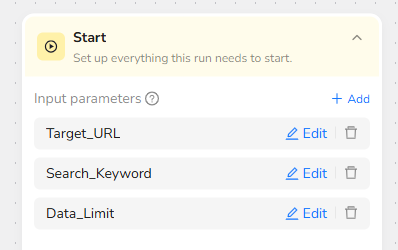
Step 2: Add Visit Page Node
Add a "Visit Page" node and input the URL “/Target_URL”. This will navigate to the Schoolhouse homepage.
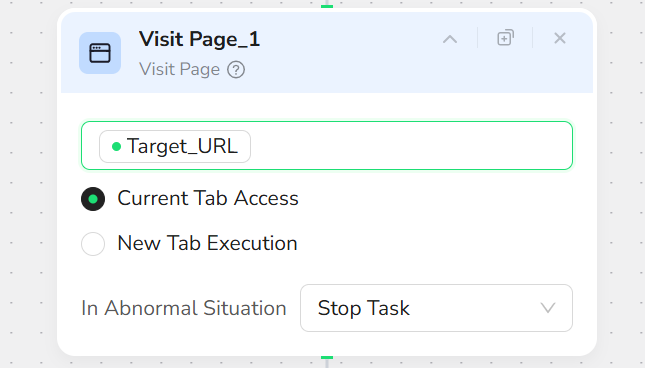
Step 3: Add Input Text Node
Add an "Input Text" node. In the Input Field Position, input “The search bar in the top-left corner of the page”. In the Text to Enter, input “/Search_Keyword”.
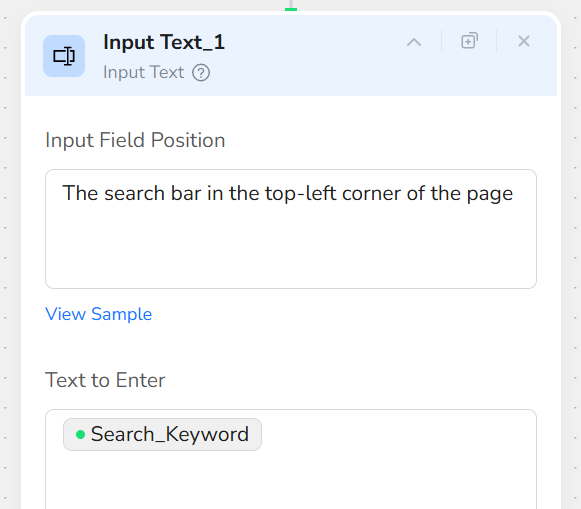
Step 4: Add Click Element Node
Add a "Click Element" node and input the prompt: “Click the search button to the left of the search bar.” This initiates the search with the provided keyword.
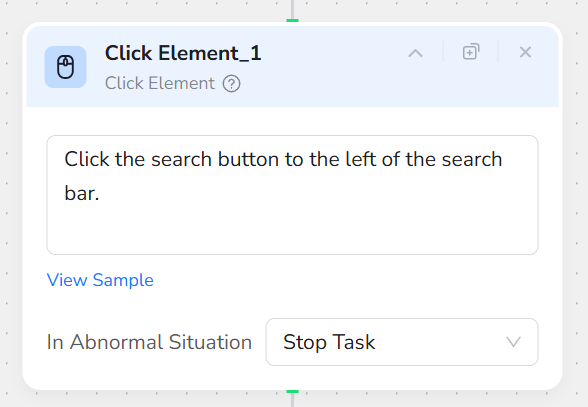
Step 5: Add Loop Node
Add a "Loop" node and input the prompt: “Continue until /Data_Limit products are collected.” This sets up a loop to collect data across pages until the limit is reached.
Step 6: Add Extract Data Node (Inside Loop)
Inside the Loop node, add an "Extract Data" node and input the prompt: “Extract from all products in the current page: Title, Price, Product URL, Image URL.
Format:
- Title: the main product headline; use 'N/A' if missing
- Price: the product price as numbers only; use 'N/A' if missing
- Product URL: the full URL of the product detail page; use 'N/A' if missing
- Image URL: the main product image shown above the title (the large hero image); use 'N/A' if missing”.
Step 7: Add Scroll Page Node (Inside Loop)
Inside the Loop node, add a "Scroll Page - Scroll to Element" node. Input the prompt: “Scroll down the page until you see the pagination”. This ensures the pagination controls are visible for navigation.
Step 8: Add Pagination Node (Inside Loop)
Inside the Loop node, add a "Pagination" node and select "Next Page". This navigates to the next page of results if more data is needed to reach the Data_Limit.

Step 9: Add Finish: Output Data Node
Add a "Finish: Output Data" node. Select "CSV" as the output format and check "Output as a file" for easy downloading. You can also choose to export in JSON, XML, or Markdown (MD) formats.
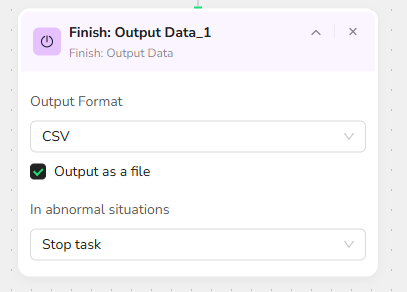
Quick Start Guide: How to Use Shopify Scraper in One Click
If you don't want to build the workflow from scratch, simply use our pre-built "Shopify Scraper – For Paginated eCommerce Stores" template for instant setup and start scraping Shopify effortlessly.
- Register Account: Create a free BrowserAct account using your email.
- Configure Parameters: Fill in necessary inputs like Search_Keyword (e.g., "Decor") – or use defaults to learn how to scrape ecommerce data quickly.
- Start Execution: Click "Start" to run the workflow.
- Download Data: Once complete, download the results file from scraping Shopify.
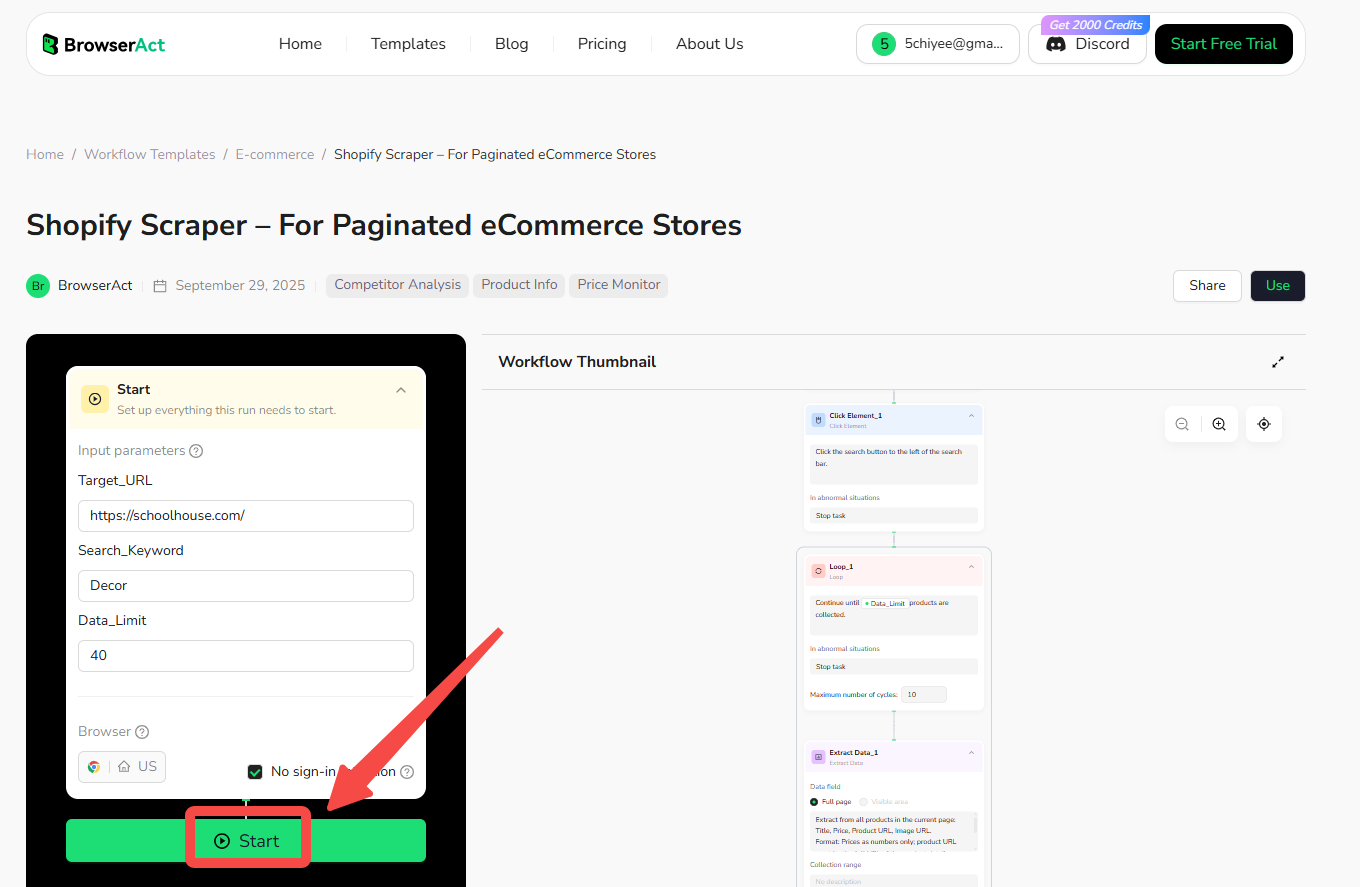
Common Scenarios for Using Shopify Scraper
Business Use Cases for Scraping Shopify Data
- Product Research: Use the ecommerce scraper to catalog products on Shopify for inventory planning and trend spotting.
- Price Monitoring: Scrape ecommerce data as a shopify scraper for competitors' pricing and images.
- Catalog Analysis: Extract data with the shopify product scraper to analyze listings and URLs.
- Market Insights: Identify Shopify ecommerce data to evaluate trends and opportunities.
Technical Integrations for Advanced Shopify Scraping
- API Calls: Integrate via API into third-party automation platforms like Make or n8n for seamless Shopify scraping.
- Scheduled Tasks: Set up regular runs to automate reports on how to scrape data from ecommerce website.
- Data Pipelines: Connect with analysis tools (e.g., Google Sheets or BI software) for ongoing data flow.
Get Accurate Results: Select the Scraper That Fits Your Site Layout
Before getting started, please make sure to identify how the product listings are displayed on the eCommerce site you want to scrape. Different websites use different loading methods, and we provide three dedicated no-code scraper templates to match:
- 👉 Shopify Scraper – For Infinite Scroll eCommerce Stores: Products load automatically as you scroll down the page.
- 👉 Shopify Scraper – For Paginated eCommerce Stores: Product listings are split across multiple pages with a “Next page” button.
- 👉 Ecommerce Scraper – For “View More” Button Stores: Products load only when clicking a “View More” or “Load More” button.
Choose the template that matches your target site’s layout to ensure accurate and complete data extraction.
Get Started with Scraping Ecommerce Websites Now
🚀 Start using it today!
- Create Free Account - 30-second quick registration
- Try This Workflow - Free trial
Custom Shopify Scraper – For Paginated eCommerce Stores Solutions
💡 Need a customized workflow?
If the existing Shopify Scraper – For Paginated eCommerce Stores doesn't fully meet your needs, we offer custom development services:
- 📧 Email Contact: service@browseract.com
- 💬 Discord Community: Join our Discord
